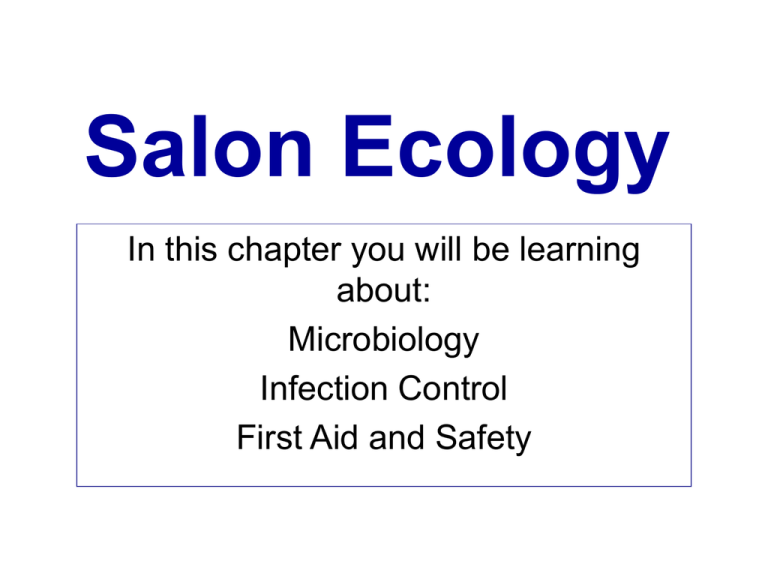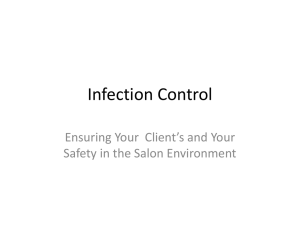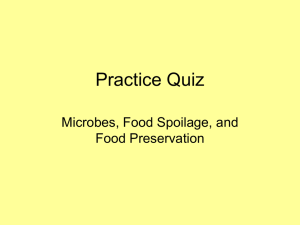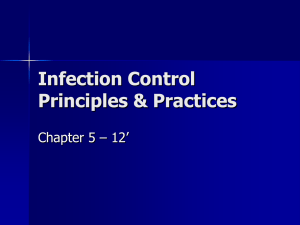Salon Ecology
advertisement

Salon Ecology In this chapter you will be learning about: Microbiology Infection Control First Aid and Safety Microbiology • The study of small living organisms called microbes, such as bacteria. • Because infectious bacteria and viruses are easily transmitted from person to person, it is important that a professional cosmetologist, coming in contact with many people on a daily basis, understands particular aspects of microbiology. Bacteria • One-celled microorganisms; germs; microbes. • The study of bacteria is referred to as bacteriology. • Germ – is a non-scientific name for small organisms, such as bacteria, fungi, and viruses that invade the body and cause disease. NONPATHOGENIC • Harmless, non-disease producing bacteria • Cause decay of refuse, improve fertility of soil • Can be beneficial (ex. Yogurt has health enhancing bacteria.) • Saprophytes – live on dead matter do not produce disease. • 70% of all bacteria are nonpathogenic PATHOGENIC • Live everywhere • Cause of infection and disease and some produce toxins. • Spread easily – In salon by using unsanitary styling implements – Or dirty hands and fingernails • Have distinct shapes that aid in their microscopic identification. Example of Pathogenic Bacterial Infection Wound Infection is caused by multiplying pathogenic bacteria which cause a reaction in the patient. Infection can be systemic, causing the patient to become ill, or local only affecting the wound bed and surrounding tissues. Pathogenic Bacteria • Cocci – Round - shaped cells – Appear singularly or in groups – There are 3 groups of Cocci • Staphlococci – Forms a bunch or clusters (like grapes) – Pus – forming – Found in boils – Cause of staph infection • Streptoccocci – Form in long chains – Pus – forming – Cause strep throat, blood poisoning, rheumatic fever and more. • Diplococci – Round and grow in pairs – Diplo means two. – Cause pneumonia • Bacilli – Most common – Bar or Rod – shaped – Cause fever, tetanus, bacterial influenza, typhoid fever, tuberculosis and diphtheria. • Spirilla – Spiraled, corkscrew shape – Cause syphilis and cholera – Treponema pallidah (a stain of Spirilla) that causes syphilis Activity Take the information you have just learned and do the exercise on the next page. Growth of Bacteria • It is very important to keep areas clean, dry and unfavorable for bacterial growth! • Bacteria grow best in warm, damp conditions. • Bacteria grow through a growth cycle that consists of two stages: – Active – Inactive Active Bacteria • Reproduce and Grow Rapidly • Grow in dark,damp,dirty areas where a food source is available. • Grow in size and divide creating two cells. • As much as16 million cells can produce in as little as 12 hours Inactive Bacteria • Condition unfavorable = No Growth • Form spores not hurt by disinfection, cold or heat. • Conditions good – they return to active stage. Movement of Bacteria • Bacilli and Spirilla have flagella (cilia) – Hair-like projections which extend from the sides of the cell. • Act as propellers to help bacteria travel through air and liquids. • Without this, movement of bacteria would be limited. Viruses • Smaller than bacteria; cause familiar diseases: Cold, Measles, Hepatitis, HIV • HBV – Human Hepatitis B; affects liver; may need vaccine; (PSW – personal service worker) • HIV – AIDS; affects natural immunity; body fluids into bloodstream of non-infected. • Cosmetologist are licensed to prevent the unnecessary spread of infectious diseases, such as HBV and HIV. External Parasites • Plants or animals that live on or obtain their nutrients from another organism. • Ringworm (tinea capitis) • Produced by parasitic plant or fungi – Contracted by improperly disinfected implements. Continue External Parasites • Scabies, Itch Mite, Head Lice – Caused by parasitic animals • Certain insects that cause contagious disease. – Head Lice • Transmitted directly from one person to another, or by contact with articles that have come in contact with an infested person. • Symptoms: scratching, redness, or small bite marks on the scalp. • Treat by using a pediculicide (lice-killing) shampoo. What do head lice look like? Louse Lice Eggs Lice Shampoo Responding Instead of Reacting • Responding to a situation means to deal with the situation in a calm mature manner. Solve the problem. • Reacting to a situation is when a person reacts first and thinks later. When we do this we may not say and do the right thing. We could end up making the situation worse. • Have empathy and be a professional. – Put yourself in the other persons shoes. Infection • Caused by pathogenic bacteria or viruses; entering the body and multiplying. – Contagious (communicable) – Can transmit through touch or the air. – Bloodborn pathogens – carried through blood or body fluids. – Primary reason behind additional infection control procedures. • Common means of spreading infection in a salon: – Open sores – Unclean hands and implements – Coughing or sneezing – Common use of drinking cups and towels – Use of same implements on infected areas and non-infected areas – Unsanitary salon conditions Universal Precautions • Wash Hands • Wear gloves whenever there is a possibility of coming in contact with blood or other potentially infectious materials (body fluids and tissues) • Wear face masks and eye protection whenever there is a possibility of blood splashing into the rescuer's face • Dispose of all contaminated sharp objects in an appropriate puncture-proof container • Dispose of all contaminated personal protective equipment in an appropriate container marked for biohazardous waste Two Basic Classes of Infection • Local Infection – Effects a small area Local Infection – Often indicated by a pus-filled boil, pimple or inflamed area. • General Infection (systemic) – Effects the whole body – Occurs when the circulatory system carries bacteria and their toxins to all parts of the body. General Infection • Asymptomatic – Carries disease – SHOWS NO SIGNS!! That’s why we have Universal Precautions! – Ex. – A person can have HIV and show no visible signs. Staph infection that is spreading Immunity • Your body can destroy an infection that enters the body, if you are immune to that particular infection. • Immunity gives your body the ammunition to fight disease. • Doctors can test the white blood cell count as a way to determine the level of illness suffered by a patient. Natural Immunity • Partially inherited, natural resistance to disease. • Body produces white blood cells and antitoxins to fight disease • Skin protects body from microbes – 1st line of defense! Passive Immunity • Acquired – Developed through the injection of antigens – Stimulate the body’s immune response – Ex: Polio vaccine Infection Control • Infection Control – Efforts to prevent the spread of disease and kill certain or all microbes. – Efficacy = effectiveness • Efficacy- “ability to produce results” or “effectiveness” • Efficacy labels are on all disinfectants to inform the user about what the product is “effective in fighting against”. • Understanding how to destroy microbes and prevent disease from spreading in the salon will help protect professional cosmetologists and their clients from the unnecessary spread of infectious diseases and maintain a safe, efficient working environment. Infection Control Pyramid • Sterilization: the most effective level of infection control. – Used on tools and implements that are used to puncture or invade the skin. – Kills – all infectious diseases. – Destroys or kills all microbes including bacterial spores. Sterilizers Sterilized Implements • Bloodborn Pathogen Disinfection: Must use an EPA-registered broad spectrum disinfectant labeled as effective against HIV and HBV or tuberculocidal. – Required for all tools and implements that have come in contact with blood or body fluids. – Kills: HIV and HBV or Tuberculocidal • Disinfection: chemical products used to destroy or kill bacteria and some viruses (except bacterial spores). – Kills - Certain bacteria – On nonporous surfaces, such as implements. Antiseptic: Product applied to the skin to reduce microbes. Clean surface on which to perform procedures and you have helped to prevent the future growth of microbes. Prevents - Growth of bacteria Ex. Numbing cream with antiseptic to apply before waxing. • Sanitation: Clean and reduce microbes on the surface, but do not kill germs. – – – – Removes - Dirt and debris 1st level of infection control Prevents the growth of microbes. Does not kill bacteria (Removes, but does not kill) Proper Hand Washing Procedure Liquid Soap vs. Bar Soap Liquid Soap In closed bottle Not exposed to microbes Bar Soap Left out wet Exposed to microbes Perfect environment for bacterial growth Disinfectant Safety • Disinfectants are powerful, professional-strength tools that can be hazardous if used incorrectly. • Can be poisonous if ingested. • Can cause serious skin and eye damage, especially in a concentrated form. Follow these guidelines when using Hospital Grade Disinfectants: • Wear gloves and safety glasses when mixing chemicals with water. • Always add disinfectant to water, not water to disinfectant. • Use tongs, gloves, or a draining basket to remove implements from disinfectant. • Keep disinfectants away from children. • Never pour disinfectants on your hands. Can cause skin irritation and increase the chance of infection. Wash hands with soap and warm water and dry them thoroughly. • Carefully weigh and measure all products to ensure that they perform at peak efficiency. • Always keep disinfectants in a marked container. • Follow manufacturer’s recommendations for mixing and using, and check the efficacy to make sure you are using the right disinfectant. • Avoid overexposure. Disinfectants are chemicals, and overuse id detrimental to the environment. • When using jars or containers to disinfect implements be sure to change the solution every day. • Or, as often as needed to keep free from debris. • Implements should be cleaned with soap and water before placing in solution. Type of tools that can be disinfected: Combs Brushes Rollers Scissors Tweezers Nail Clippers OSHA • Department of Labor regulatory agency • Occupational Safety and Health Administration • Regulates and enforces safety and health standards to protect employees in the workplace. MSDS • Key info on product ingredients. • Material Safety Data Sheets. – Information about hazardous ingredients, safe use and handling procedures, precautions to reduce the risk of harm and overexposure, flammability and data in case of a fire, proper disposal guidelines, and medical information should anyone have a reaction to the product. EPA • Approves efficacy of products. • Environmental Protection Agency – The EPA licenses different types of disinfectants. – The type used in the salon are hospital grade disinfectants that kill HBV, HIV and tuberculocidal. FIRST AID First Aid Accidents and emergencies happen everywhere. Basic knowledge of first aid will prove invaluable. Bleeding and Wounds • Step 1 – Place clean cloth or gauze and gloved hand over wound. Apply firm pressure for 5 minutes. • Step 2 – Call 9-1-1 (if bleeding is severe) • Step 3 – Elevate injured arm or leg above level of victims heart if practical. • Step 4 – When bleeding stops, secure cloth with a bandage – Don’t lift cloth to see if bleeding stopped. Make sure that bandage is not too tight. Chemical Burns 1. Rinse away all traces of chemicals while moving away any contaminated clothing. 2. Cover burn loosely with clean, dry cloth. 3. Refer person to medical personnel. Heat or Electrical Burn 1. If skin is not broken, immerse in cool water or gently apply cool compress. 2. Do NOT break a blister if one forms. Do NOT apply ointments or creams. 3. If skin is broken or if burn is severe: • • • Call 9-1-1 Do NOT clean Cover burn 1st Degree Burns • First Degree • Symptom is redness • Burn only effects the surface, the epidermis layer of the skin. • Apply ice or cold water. 2nd Degree Burns – Second Degree • Symptom is redness and watery blisters. • Burn effects the two upper most layers of the skin (epidermis and dermis). • Apply ice or cold water and may refer to a physician. 3rd Degree Burns – Third Degree • Symptom involves deeper structures of flesh and possible charring of tissue. • Burn effects all 3 main layers of the skin (epidermis, dermis and subcutaneous) and may even reach the muscle. • Refer to a physician immediately! 1st, 2nd, and 3rd Degree Burns Choking Step 1 – Determine if victim can talk or cough. If no, have someone call 9-1-1, while you do abdominal thrusts. Step 2 – Stand behind victim; wrap arms around his/her stomach. Step 3 – Make thumbless fist with one hand and place that fist just above navel and well below the ribs with thumb and forefinger side toward the victim. Step 4 – Perform upward thrust by grasping fist with other hand and pulling it quickly toward you; repeat if necessary. Fainting • Step 1 – lay victim down on back – allow plenty of fresh air. • Step 2 – Reassure victim and apply cold compress to face • Step 3 – If victim vomits, roll onto side, keep windpipe clear. • Call 9-1-1 if victim does not regain consciousness. Chemical Eye Injury • Hold eyelids apart – flush eyeball with luke warm water for 15 – 30 minutes; don’t let runoff flow into the other eye. • Place gauze pad or cloth over both eyes and secure with bandage. • Get to an eye specialist or emergency room immediately. Cut, Scratch or Embedded Object in Eye • Place gauze pad or cloth over both eyes and secure with a bandage. • Do NOT try to remove an embedded object! • Get to an eye specialist or emergency room immediately. Examples of Object In Eye










